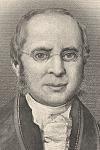

Rev. Dr. George Oliver
(1782-1867)
This English Masonic author
although being a well respected writer on ecclesiastical antiquities was also
responsible for some mistaken theories and fanciful speculations concerning the
early
history of Freemasonry. His Masonic writings which were not well
researched
would place him as probably the founder of the Literary School of Freemasonry.
He believed that the Order was to be found in the earliest periods of
recorded history. It was taught by Seth to his descendants, and practiced by
them
under the name of Primitive or Pure Freemasonry. It passed over to Noah, and at
the dispersion of mankind suffered a division into Pure and Spurious. Pure
Freemasonry descended through the Patriarchs to Solomon, and thence on to the
present day.
Bro. George Oliver was initiated in 1801 at age 18 (by dispensation due to
age) by his father, The Rev. Samuel Oliver, in Saint Peter's Lodge No. 442 in
the city of Peterborough, he entered Holy Orders in the Church of England in
1813, and in 1835 the Archbishop of Canterbury conferred upon him the degree
of
Doctor of Divinity. He read with great attention every Masonic book he
could obtain, and began to collect a store of knowledge which he afterward used
with so much advantage to the Craft. In 1829, he edited a new edition of
William Preston's "Illustrations of Masonry."
His own first contribution to the literature of Freemasonry was a work
titled "The Antiquities of Freemasonry" and was published in 1839. His next work
titled "The Star in the East", intended to show, from the testimony of Masonic
writers, the connection between Freemasonry and religion. In 1841 he
published his 12 lectures on "The Signs and Symbols of Freemasonry" , in which
he
went into learned detail of the history and signification of all the recognized
symbols of the Order. This was followed by 12 lectures on "The History of
Initiation", comprising a detailed account of the Rites and Ceremonies,
Doctrines and Discipline, of all the Secret and Mysterious Institutions of the
Ancient World. The professed object of the author was to show the resemblances
between these ancient systems of initiation and the Masonic, and to trace them
to
a common origin - a theory which, under some modification, has been very
generally accepted by Masonic scholars.
His "Institutes of Masonic Jurisprudence" , was a book in which he expressed
views of law that did not meet with the universal concurrence of his English
readers. Besides these elaborate works, Doctor Oliver was a constant
contributor to the early volumes of the London Freemasons Quarterly Review, and
published a valuable article, on the Gothic Constitutions, in the American
Quarterly Review of Freemasonry. It seems the great error of Doctor Oliver, as a
Masonic teacher, was a too easy credulity or a too great warmth of imagination,
which led him to accept without hesitation the crude theories of previous
writers, and to recognize documents and legends as unquestionably authentic
whose truthfulness subsequent researches have led most Masonic scholars to doubt
or to deny.
In 1815 Oliver became a member of the Ancient & Accepted Rite in England and
in 1845 was promoted by the SC of England to the 33rd Degree and in the same
year was
appointed Lieutenant Grand Commander, being advanced in 1850 to the highest
dignity, that of Most Puissant Sovereign Grand Commander. In 1846 the
Grand
Lodge of Massachusetts conferred upon him the honorary rank of Deputy
Grand
Master.
![]()